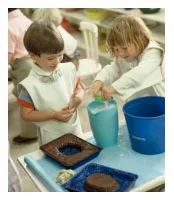Motor Education & Exercises of Practical Life
Maria Montessori teaches us to present to the children the way to do things. We present with great detail and great care. But this does not mean we expect them to be little, obedient robots. Here are her words explaining the solution to this problem:
Everything must be presented and everything must be connected with life; but this does not mean that the actions which children have learned to perform and to integrate with their practical lives should be expressed or directed by us in every detail. This integration of his actions is one of the highest efforts that a child can make. A child has learned not only how to keep silent, but when he should be silent. He has not only learned various kinds of greetings but he has also learned which one to use with another child, with his own mother or father, with a stranger or with one who is old and respected. In other words, he must use, according to time and circumstances, the many things he has learned perfectly. But it is he who makes the decision.

These little cuties know that making soap suds is not part of the lesson
on the island and the lake! But they are having a grand time,
and they put all their work away when they are finished.
The coordination of the child’s movement comes only with activity. Therefore, the child who is lively by nature looks for different types of work that, through the necessity of nature, coordinate his movements. Everything that we offer the child that has motion and action is tremendously interesting to him.
With well-selected exercises, we can help the child do more flawlessly what he already wants to do: perfect his movements, improve coordination, and gain independence.

Montessori describes the highest form of movement as synthetic movement, i.e., movement directed by the mind to an intelligible purpose. So here we have some examples of Montessori Practical Life activities that are designed with clearly identified purposes: learning to buckle, walking heel to toe on a line, and making orange juice; all real-life, day-to-day activities that children like to do.
The child has a fundamental need to act. When we fully understand this need and realize that, when we couple his need for movement with great things to learn, we can accomplish powerful developmental goals in a natural, joyful atmosphere in our homes and Montessori schools.






















